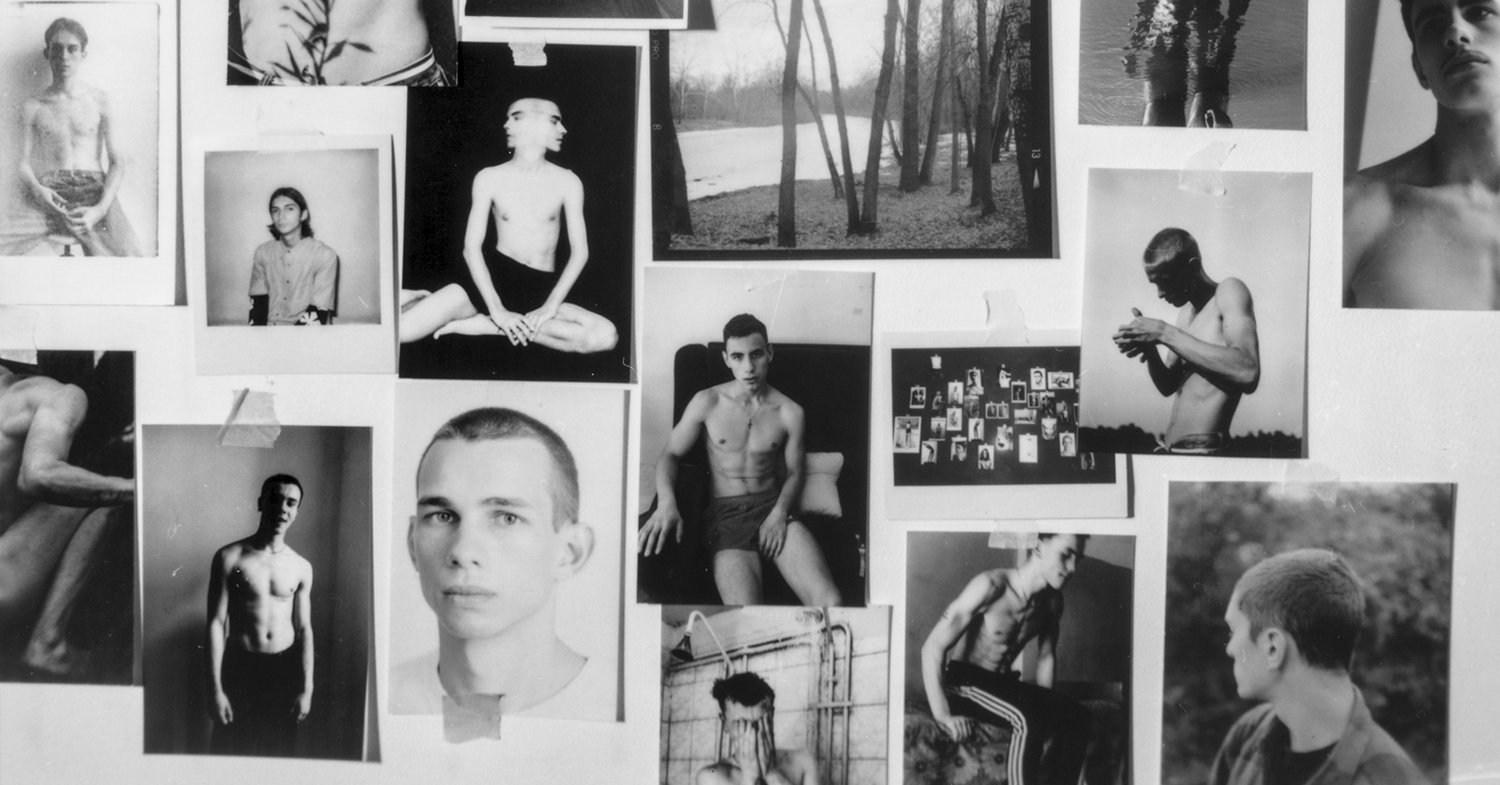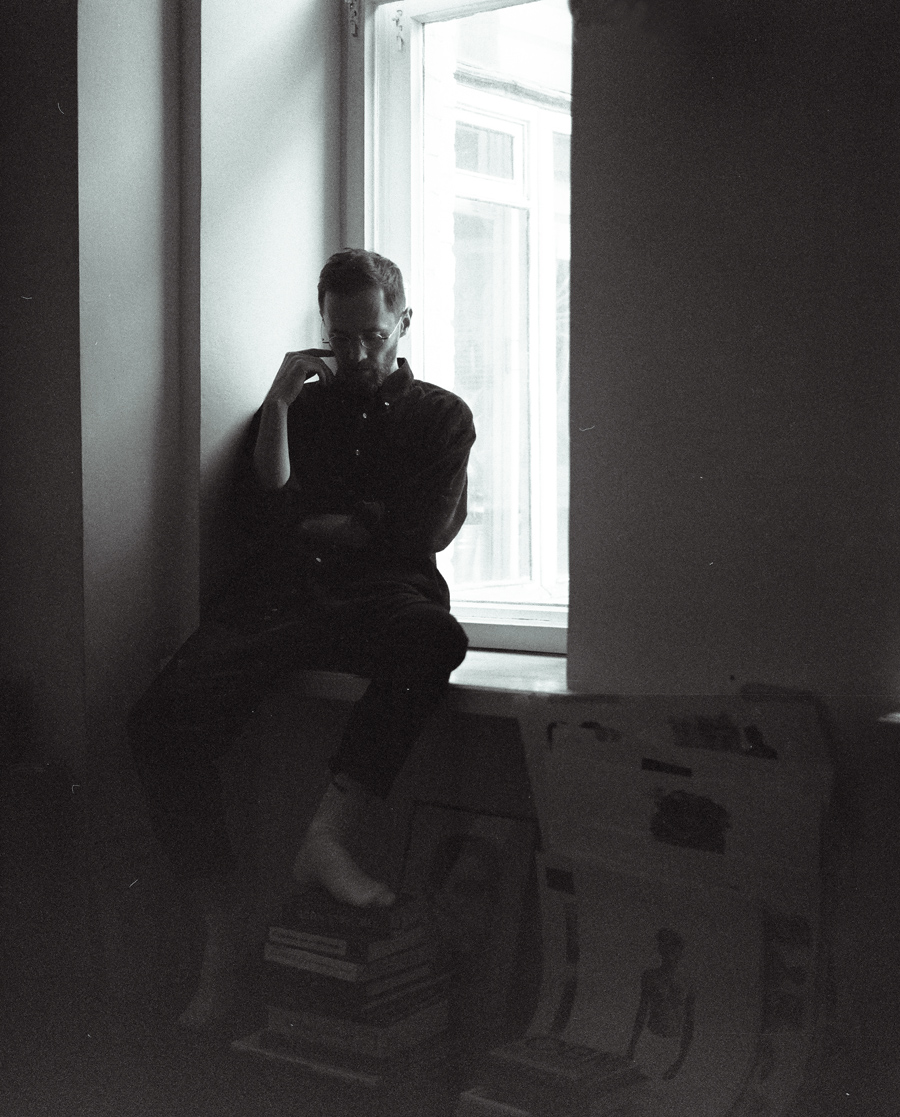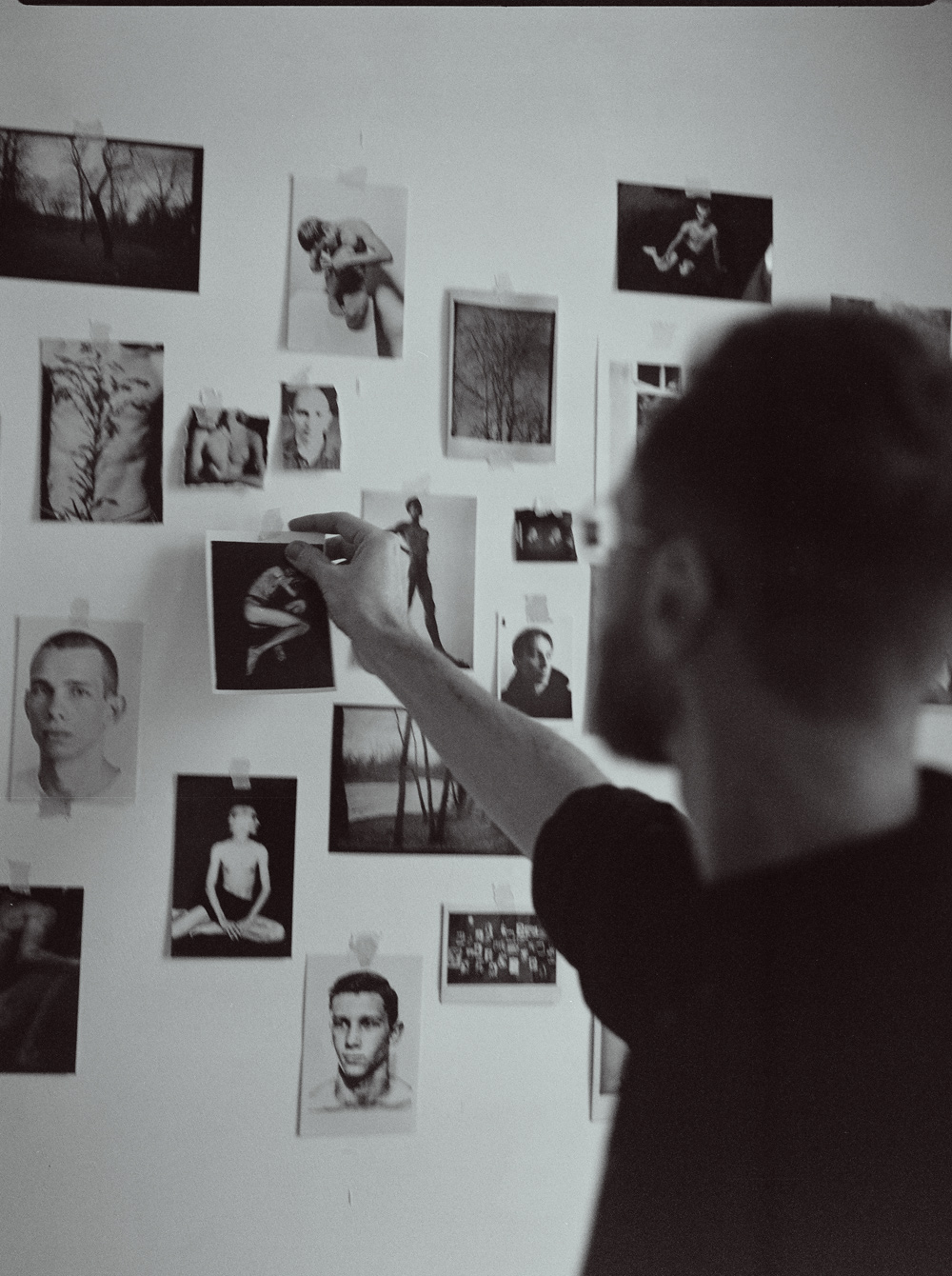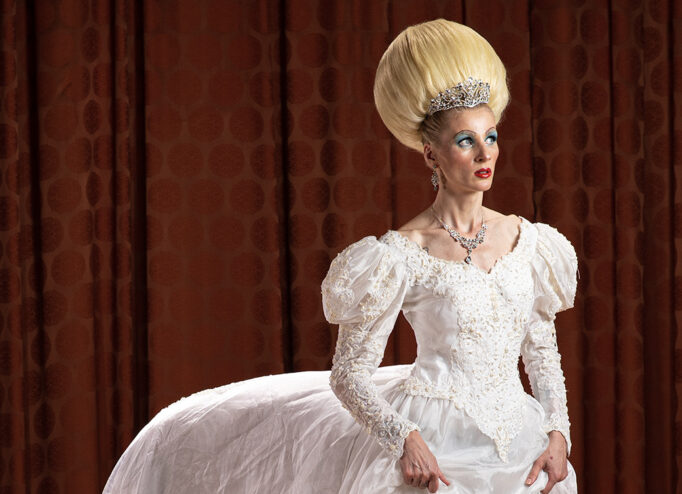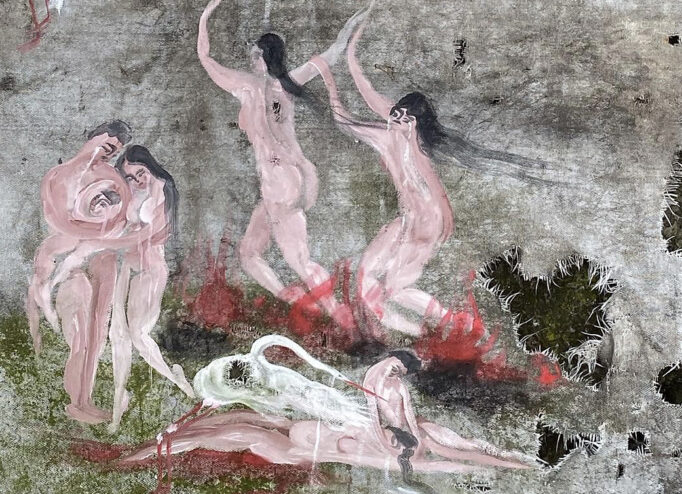Vic Bakin is one of the most prominent and consistent Ukrainian photographers who work with the topic of male nature. He started with modeling tests and shoots for L’Officiel Online: his first series on male beauty was published there. Later he began to work on the series «Fountain Of Youth» in which he photographed only young men, trying to capture the moment of maturity that comes to every man.
His work along with other photographers from Kyiv was published in the ∄ zine in 2020, and a year later, the club’s label, Standard Deviation, took his picture on the cover of the first vinyl release and published a solo photo book Heavy Clouds. There Bakin presented photography as an object for the first time, complementing his shots with paint.
At the request of DTF Magazine, Nastya Kalita met Vitya and talked to him about his interest in exploring masculinity, his attempts to record the symbiosis of strength and tenderness, his dorm shooting and unwillingness to come into contact with dark and dirty, as well as about new projects and attempts to touch the beauty of women. In addition, we publish some new photos of Vitya for the first time
— How did the topic of exploring male beauty (that’s how I define your work for me) arise in your practice, and why is it male beauty?
— In a way, I am really a researcher of male beauty. However, I started taking pictures of girls quite recently, too. Previously, I just couldn’t understand them, and all the pictures turned out ridiculous because of some kind of awkwardness, I guess. I didn’t go into that space for a long time and photographed what I knew very well, namely youth and guys. Who I was myself was my photographic comfort zone, which I gradually started to climb out of.
— Started to climb out of?
— I’ve photographed girls before, but it was rare. It seems to me that two factors played a role here. The first one is that girls are often too picky about their appearance, and the second one is that there is a certain pressure from the outside on the female sex: you have to be beautiful, thin and well-groomed. My work just didn’t work out with that in mind: the girl looked somehow ridiculous and strange in the pictures. And I couldn’t understand this corporeality.
There is still a belief that it is necessary to distinguish between the two worlds, namely the male and the female. So I took up the part that was more familiar to me.
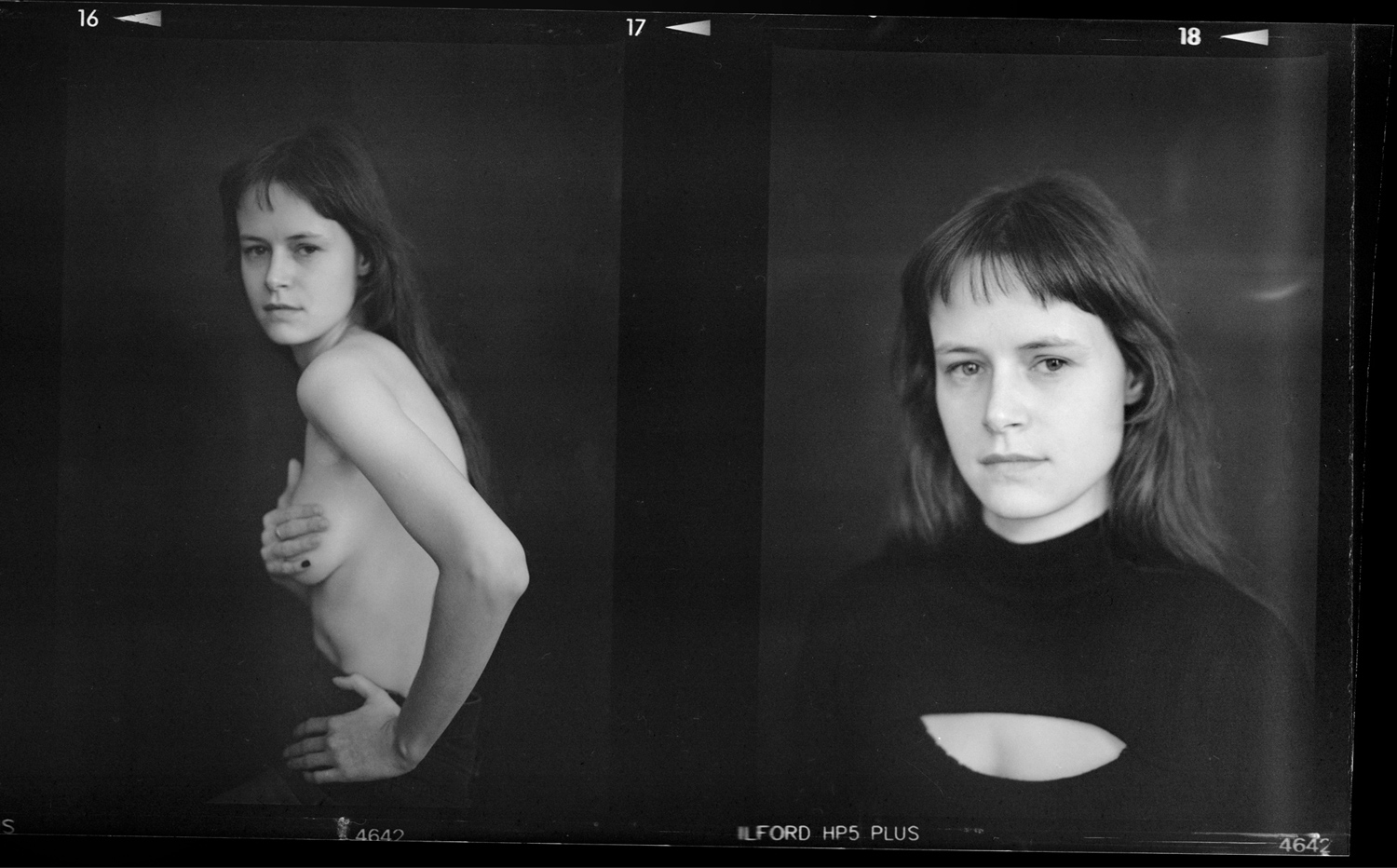




— You started taking pictures of girls nonetheless. Are they still ridiculous?
— No, apparently something had changed in my mind, but I couldn’t get to it yet. I wanted to see everyone, boys and girls alike, as people, without regard to gender.
— Tell us more about how you work with photography. And how did you get interested in it?
— I grew up in Ivano-Frankivsk and studied IT. Then I got sad and bored while working in a bank and decided to move to Kyiv. Here it was as if I woke up creatively, it happened in 2010. At that time I got a simple camera and started taking pictures to get closer to people. Gradually I got sucked in and moved on to model shoots, snaps, tests and so on.
It was all done in a box, namely a virtual box in the time of flickr. Then people started to notice me, even interview me, and the story of photographing male nature gradually took shape into something more concrete. I liked what was going on around me: I was meeting new people, communicating, taking photos, taking incredibly beautiful pictures (as I thought).
— Were the male nude shots also in 2010?
— No, they appeared gradually, I didn’t go in that direction right away. You take a picture of a person, you take a normal portrait, but then he offers to take a nude picture, and you agree. There’s no expectation of that kind of photo beforehand. You don’t know what you might get, and you end up going with the flow. It’s only later that you realize that you’re opening up a whole subject.
— What do your projects consist of? How do they start and move forward? What methods of work do you use? Do you have a permanent series (I think it’s «Youth»)? How do you work on it?
— For me, photography is a process of discovery. Each shot leads to the next. What I shoot could be called a personal diary.
I take pictures at least two days a week. I try not to forget the craft, despite a lot of other things to do. I work on several projects at the same time, depending on what I come across or what kind of person I come across. I try to figure out where it works best.
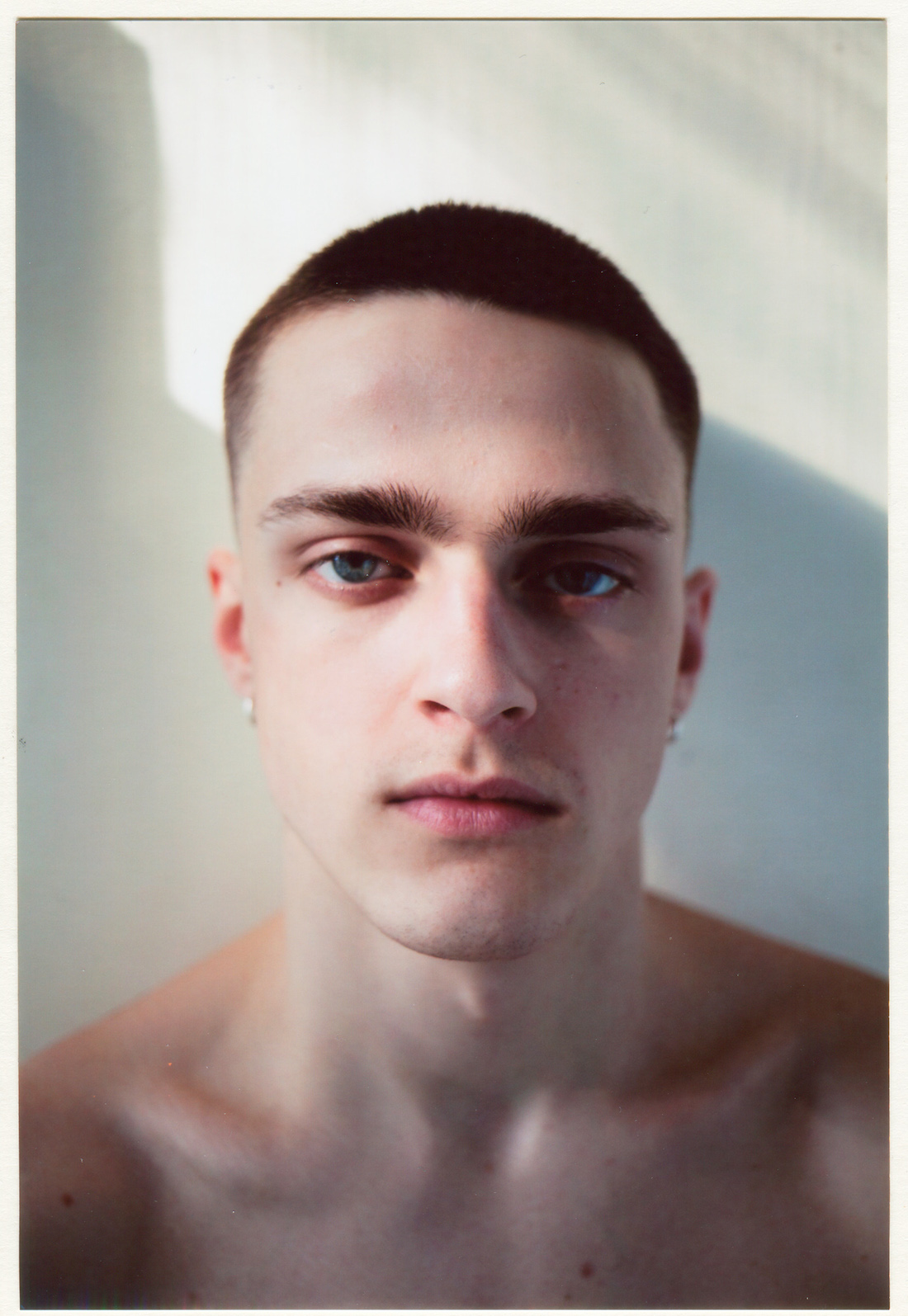

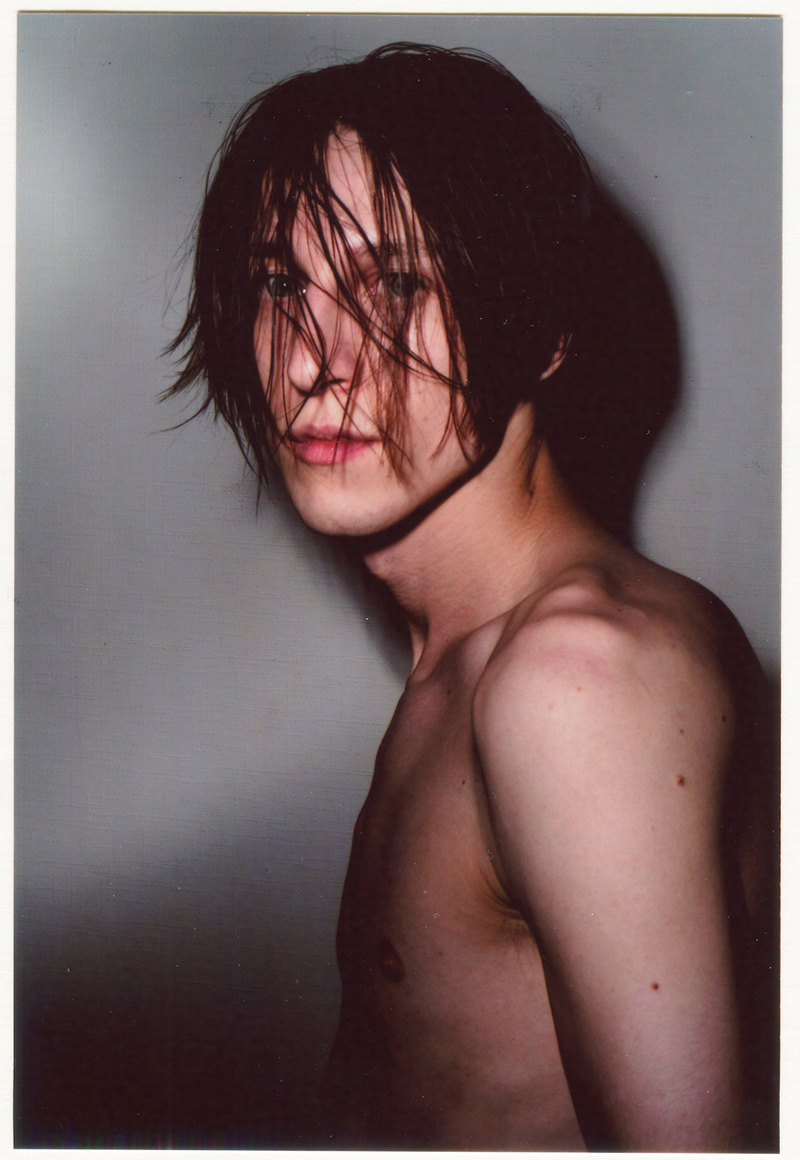
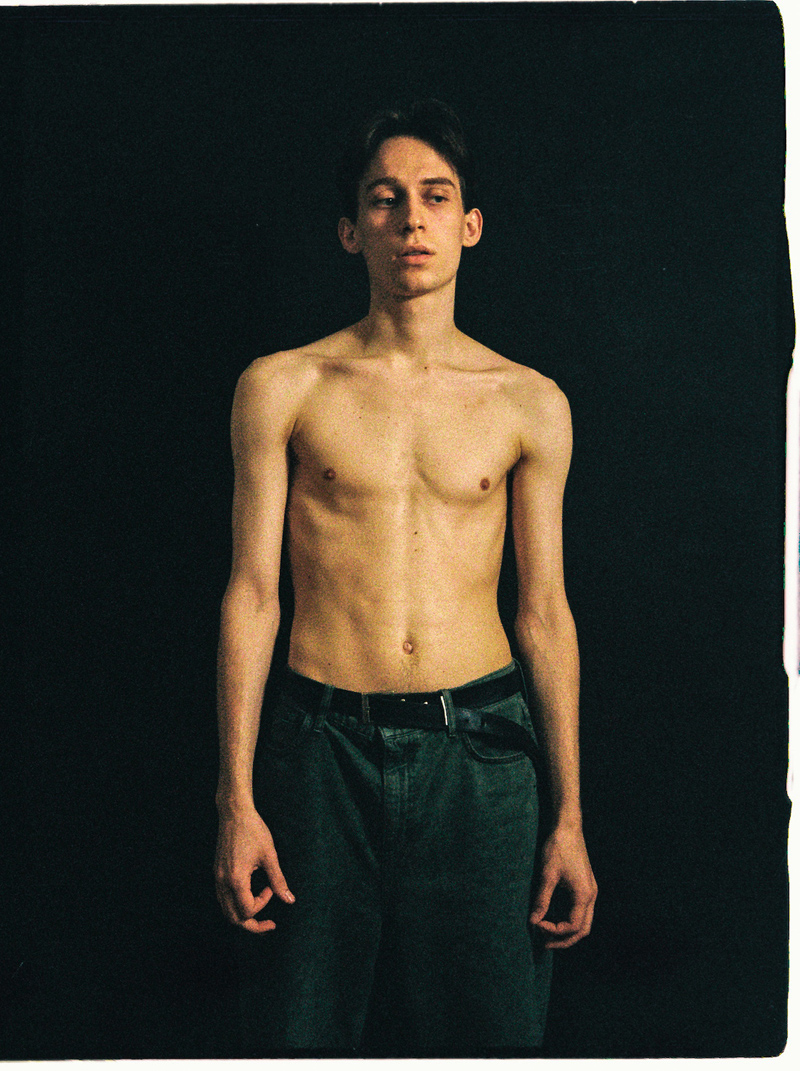
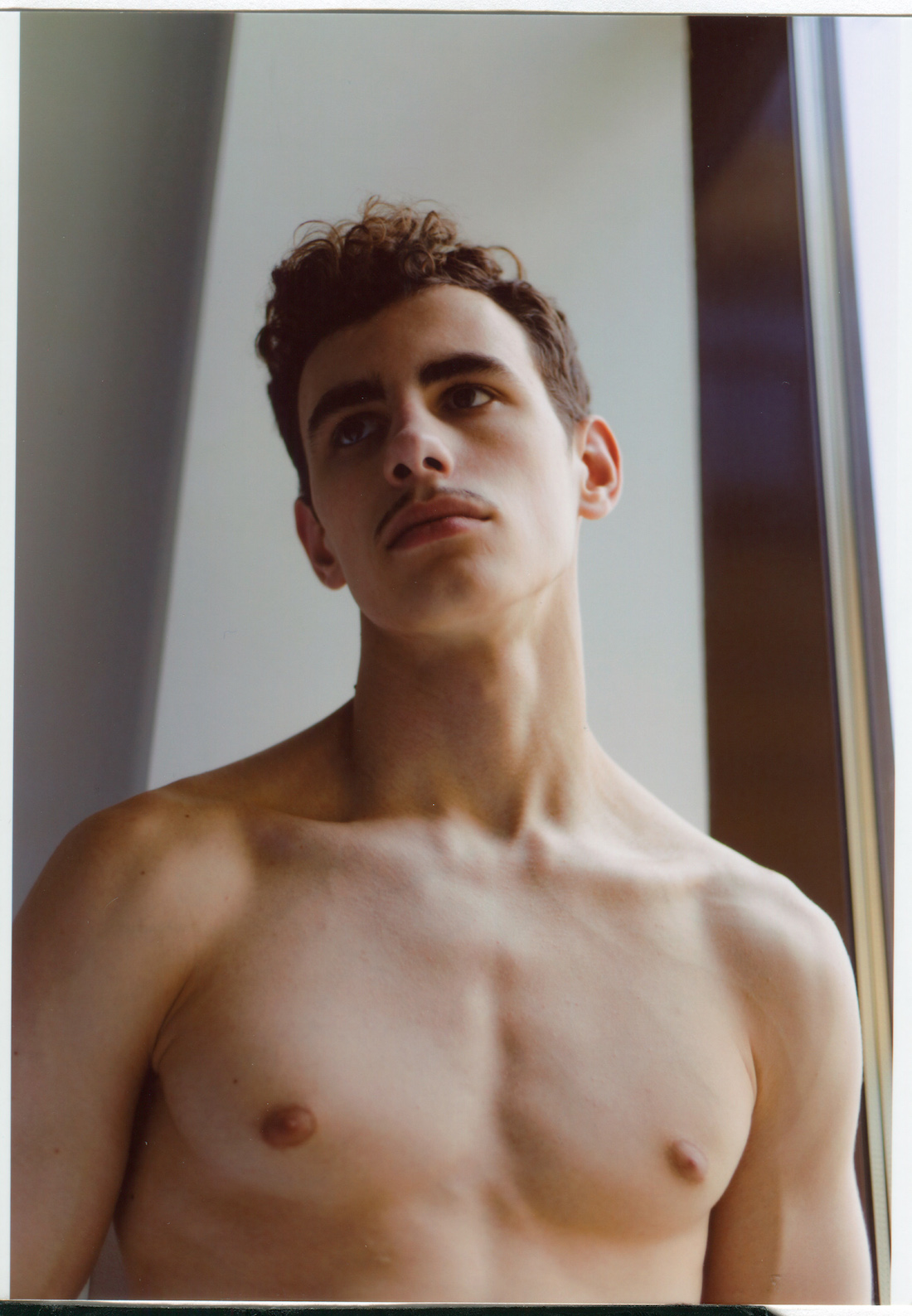
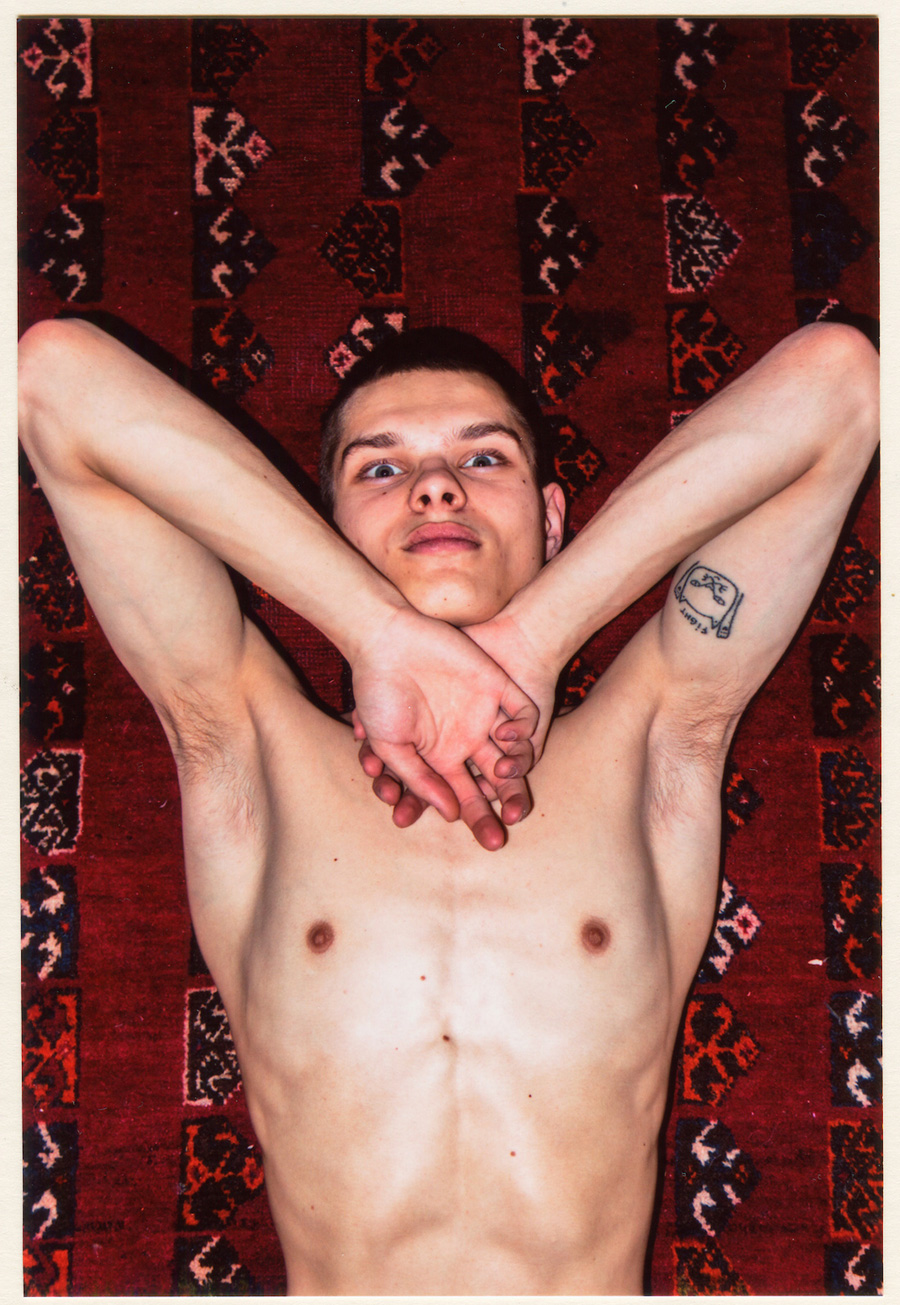
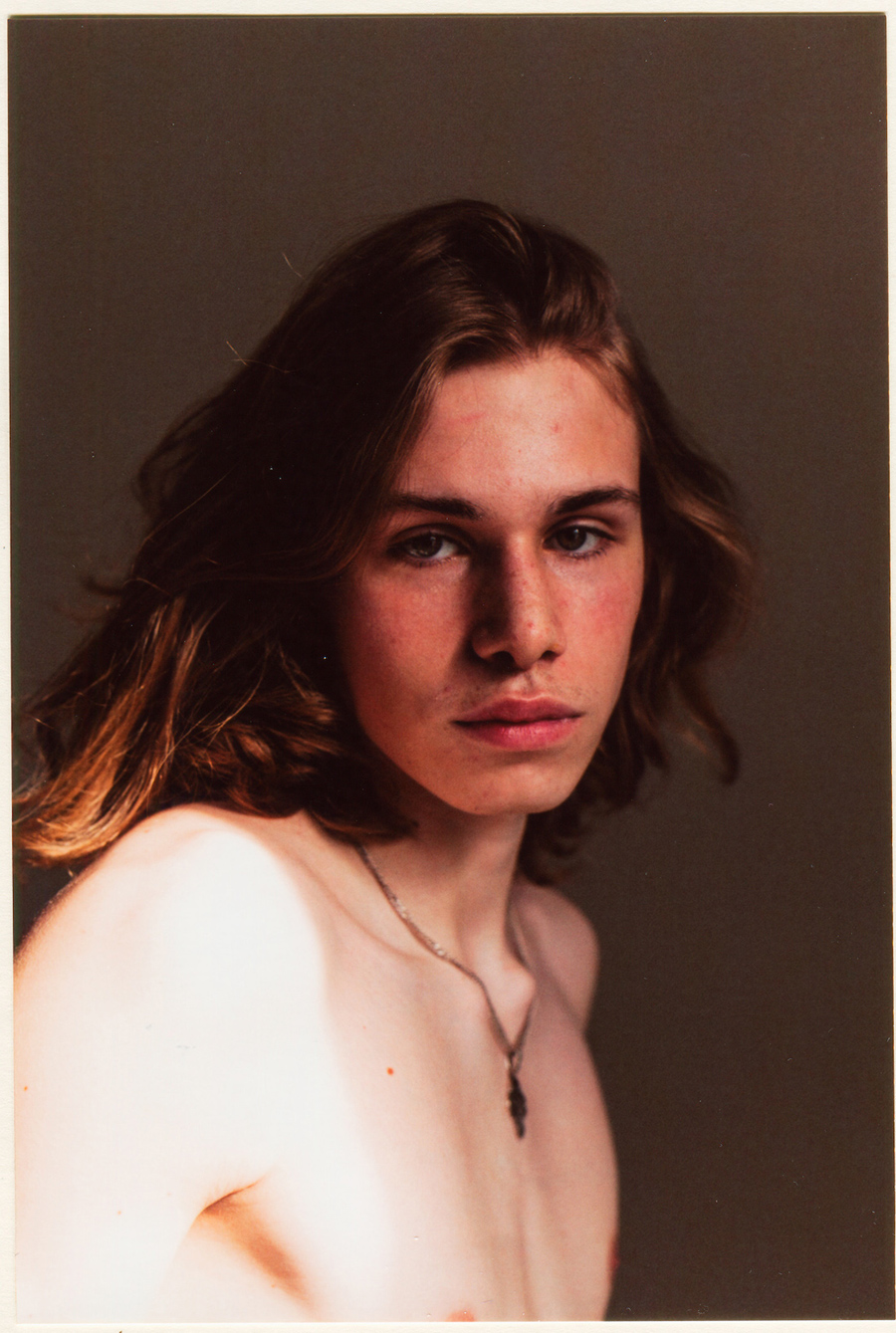
The main project, Fountain Of Youth, started a long time ago and is still ongoing, it’s an ongoing series. I labeled it as a forever ongoing project because it is something that interests me beyond time. Youth is a short and intense period, the transformation seems to happen exponentially.
You realize how different the person is when you see each other after a year. It’s like he’s different, it’s a real metamorphosis.
I remember from my own experience, this is the most tumultuous and contradictory period in my life. It is the ambivalence of strength and tenderness. It is the onset and accession of masculinity. I am trying to capture and decipher this special and unique moment of «crisis» and coming to my senses.
— You once said that when you see a person, you understand what project suits that person, what emotion that person might represent. How does this happen? You look and think: Masha doesn’t fit, but Olya is the right one, right?
— In fact, it’s a lottery. Sometimes you meet the right person online, but it’s a total disconnect when that person comes to your studio.
— What do you do in these situations? Do you take pictures?
— I shoot either way, but not for long. I’m always looking for presence when I’m shooting. Sometimes a miracle happens: you cross a certain membrane — and the person suddenly opens up. To achieve this, I need to bare my doubts and accept them, I need to be vulnerable too.
— Does it happen that you choose everything perfectly, and then you shoot it and nothing comes out?
— Yes, it works the other way, too.
— Have you had many such failures?
— There’s less chance of a complete disconnect. The question here is how much you need to dig for the truth under layers of armor. There are times when you have to do a lot of digging, and sometimes a person comes to you, sits down, and you realize that this is it — you just need to take a picture.
I felt a kind of «modelling» professional deformation when I switched to models at the beginning of my journey in Kyiv: a person standing in front of you, and it seems that this is not a person, but his/her role. It was not always easy to break this protection.
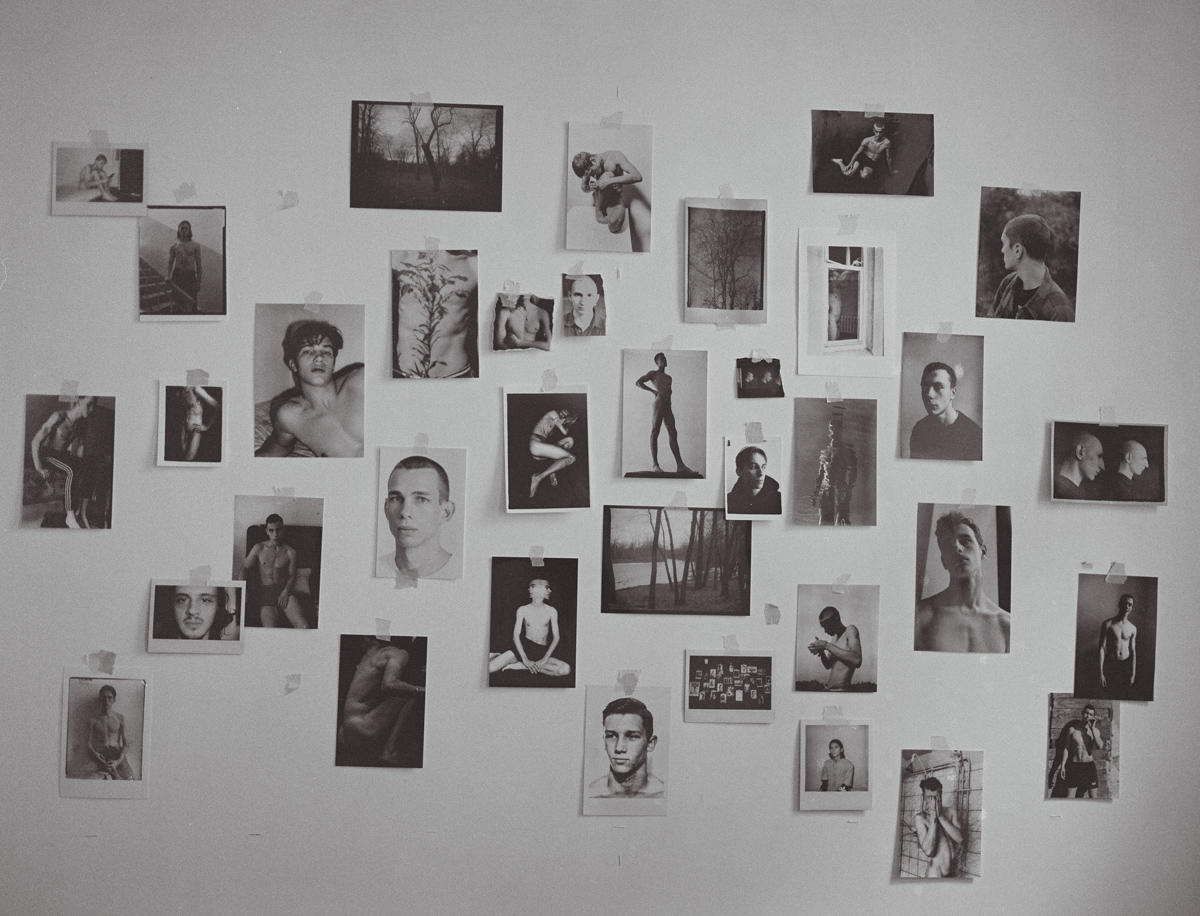
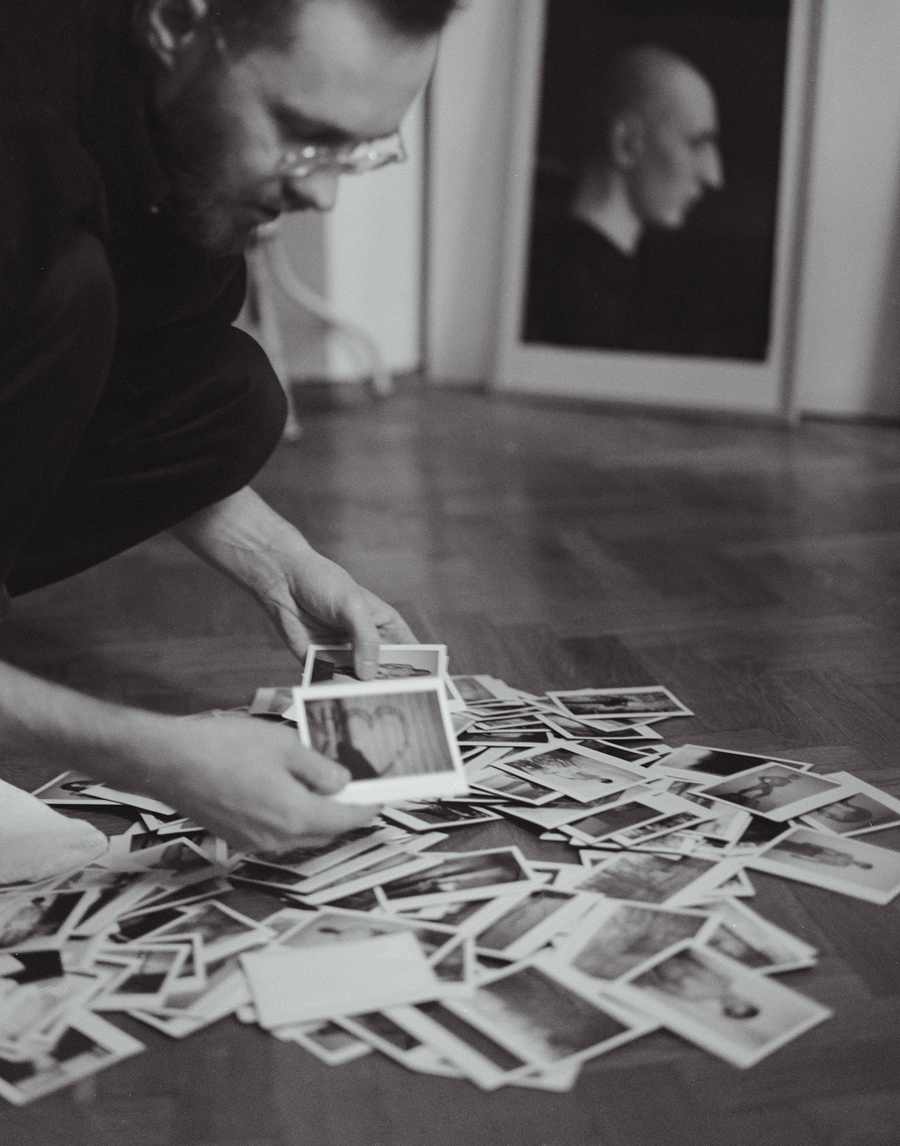
— Acting is required in such cases. But do you need the person as such?
— Exactly. Person is under that protection, somewhere out there, far away or close.
— How do you guess that’s your hero after all?
— I think it happens on the level of intuition. Sometimes it happens that I see an interesting person, but I don’t understand how to catch him or photograph him. It really takes fortune, a little work, and a bit of luck. That’s it!
— And how do you know that the picture has turned out?
— I look at the picture and realize that it is timeless. It probably depends on intuition, too. The vocabulary isn’t big enough to describe the range of feelings you get when you look at a picture. You can write «beautiful, true», but your feelings go much deeper than that.
— Would you like to shoot your characters from the project «Youth» after years? How will the project develop further?
— I once took a picture of a friend of mine. That was two or three years ago. I realized it was a different person when I met him more than a year later.
There is an American photographer, who shot four sisters for forty years in a row, taking one shot a year. I think his last name is Nixon.This transformation is a very interesting subject, but it takes time and persistence, you have to find the person and not lose that person. I don’t keep in contact with everyone: life goes on, and the environment changes like a river flows. But I have a few guys and I make a habit of shooting them every year.
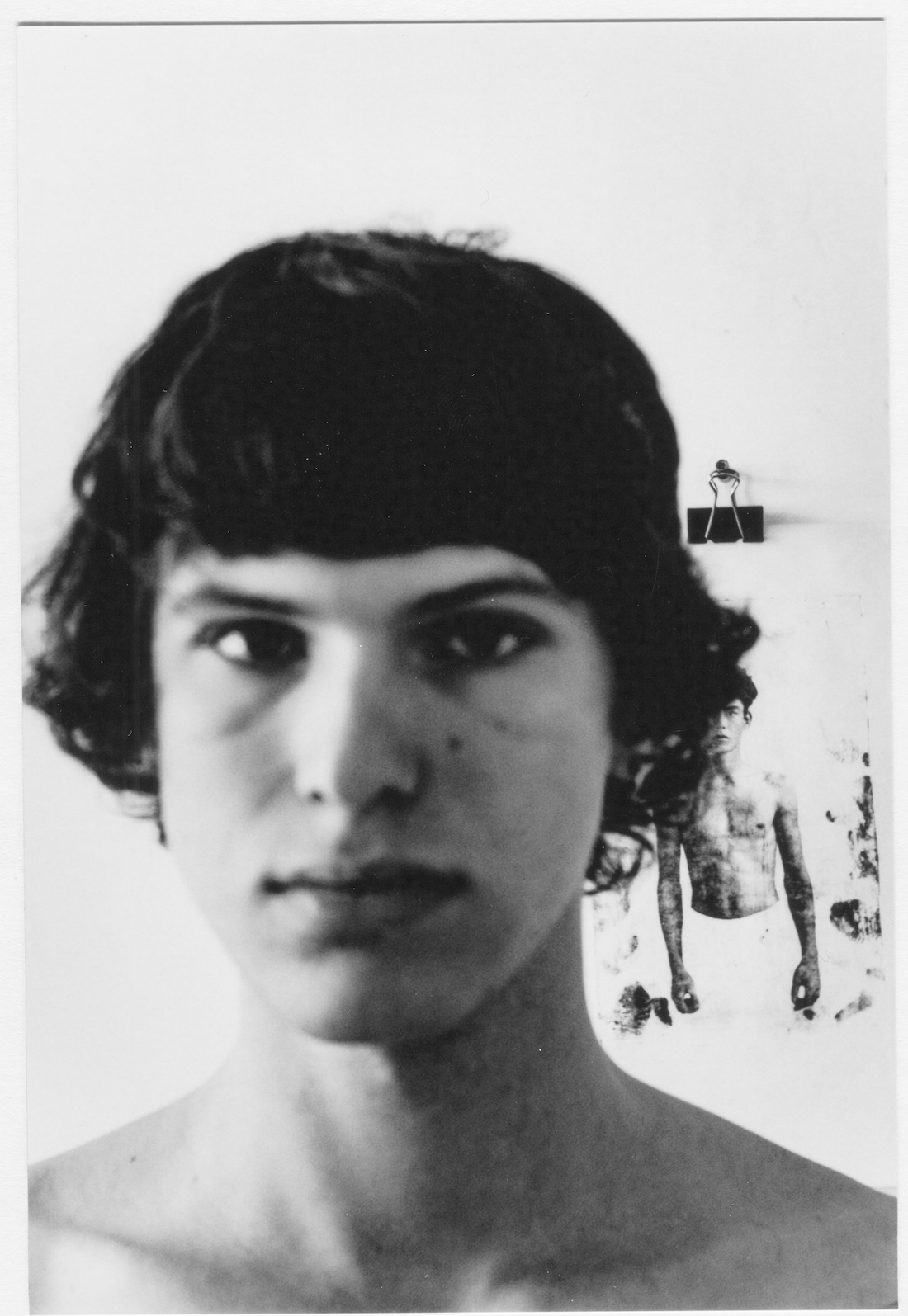

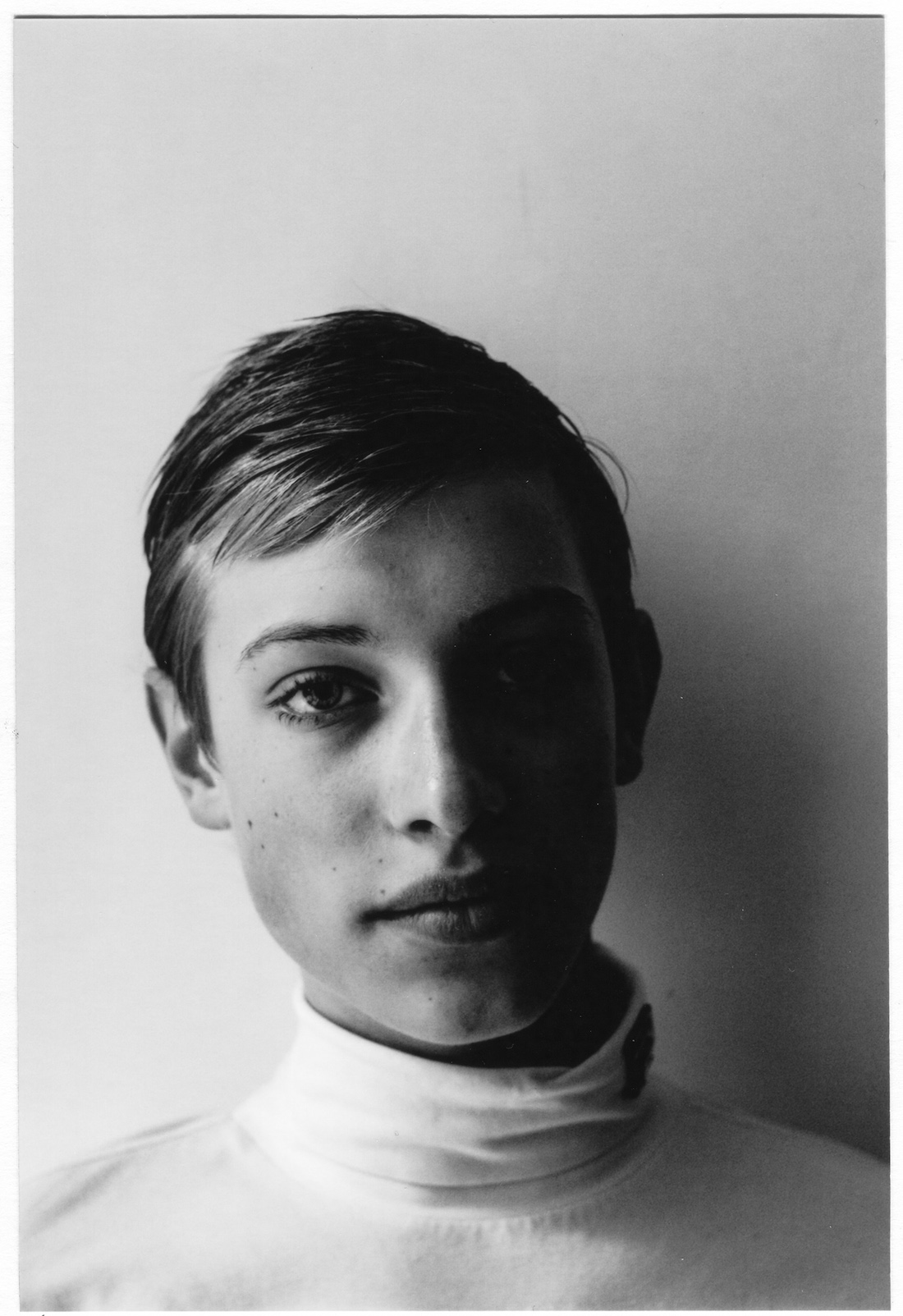


— Rodion is the hero of an image in VOGUE magazine as part of their project «Picture of the World. Art in Self-Isolation». This is my favorite of your pictures. Besides the beauty, it has some socio-political undertones. Even your commentary is an introduction to a certain story. It’s not just about beauty, it’s a whole context.
— Yes, and I’ve learned over time that studio photos are interesting, but you see so much more when you go out into real life. You see the multi-layered intersections of different destinies.
I shot this portrait in a dorm, then it ended up in VOGUE. And then it ended up in an exhibition at Port.Agency. We spent three hours in the hostel there, we talked to each other, stopped by the neighbors and so on. This was before the pandemic.
— The portrait is quite spontaneous. Was it made in the process of some kind of relaxation?
— Yes, exactly. But at the same time I was shocked by the way of life I saw. It was a railroad high school. I was horrified at how people could live in such conditions: there were six people in a small gloomy room, bunk beds, everything was worn out… I went to some hell when I left my studio, my comfort zone. But this world is interesting in its own way.

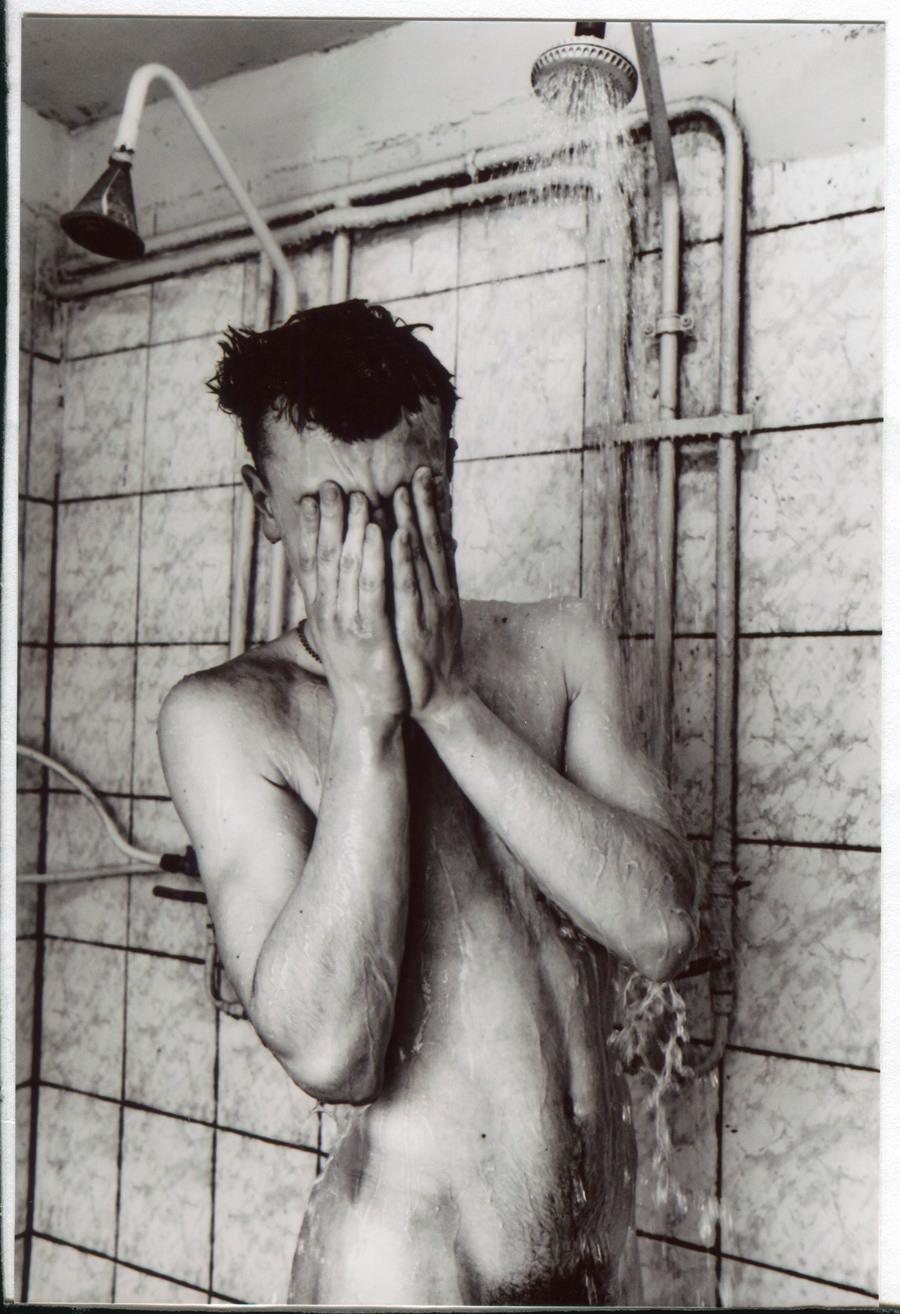
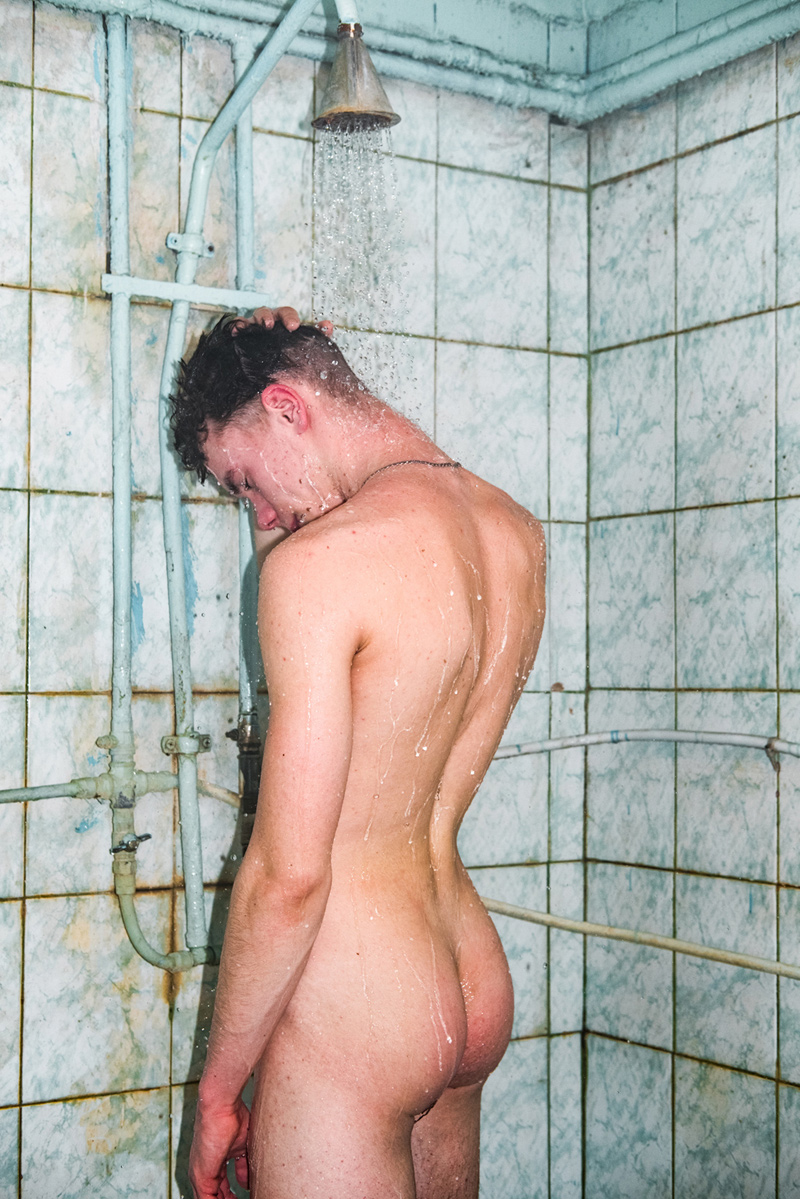
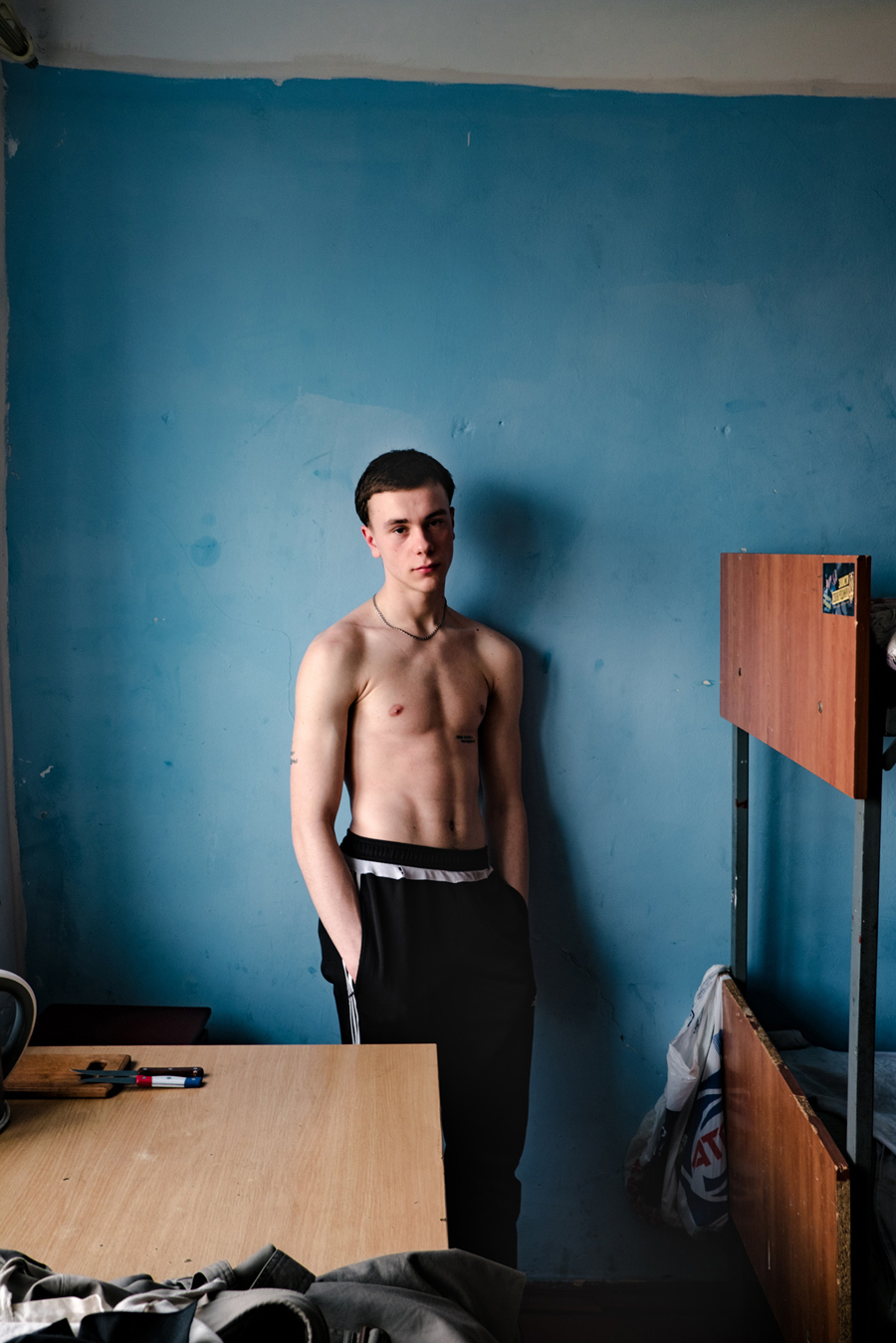
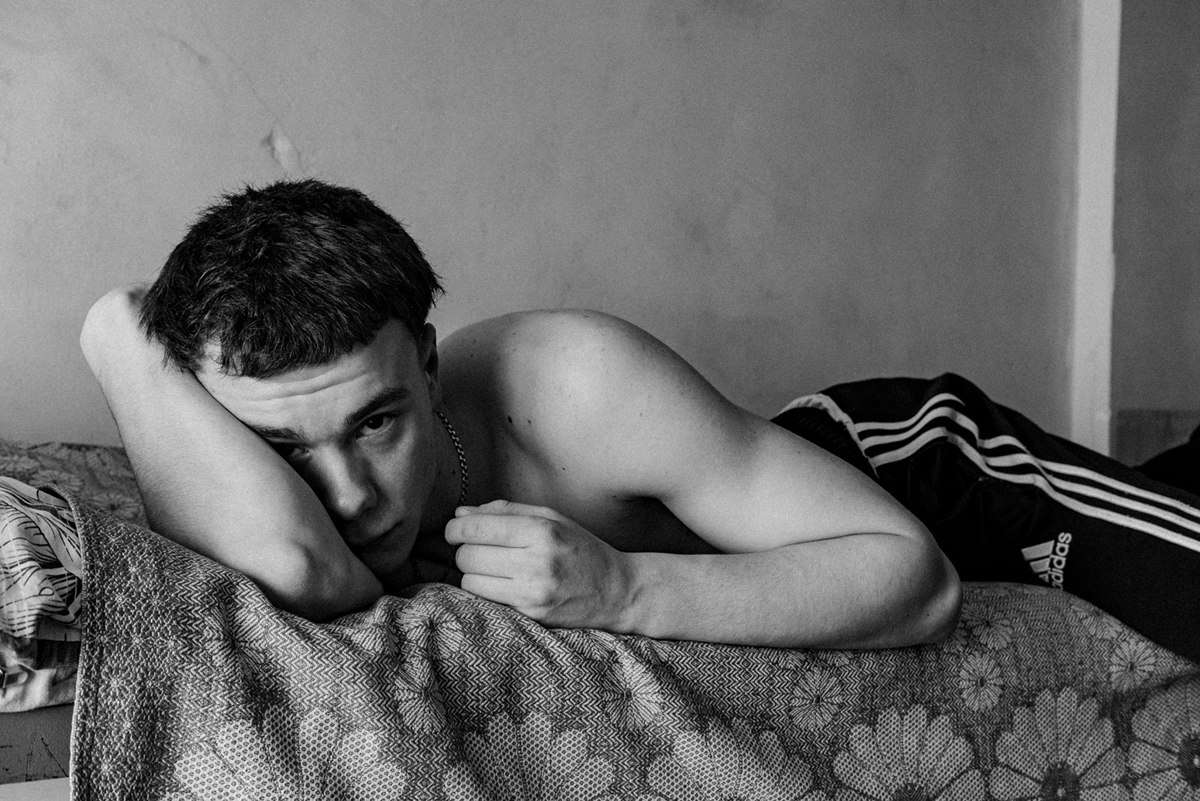
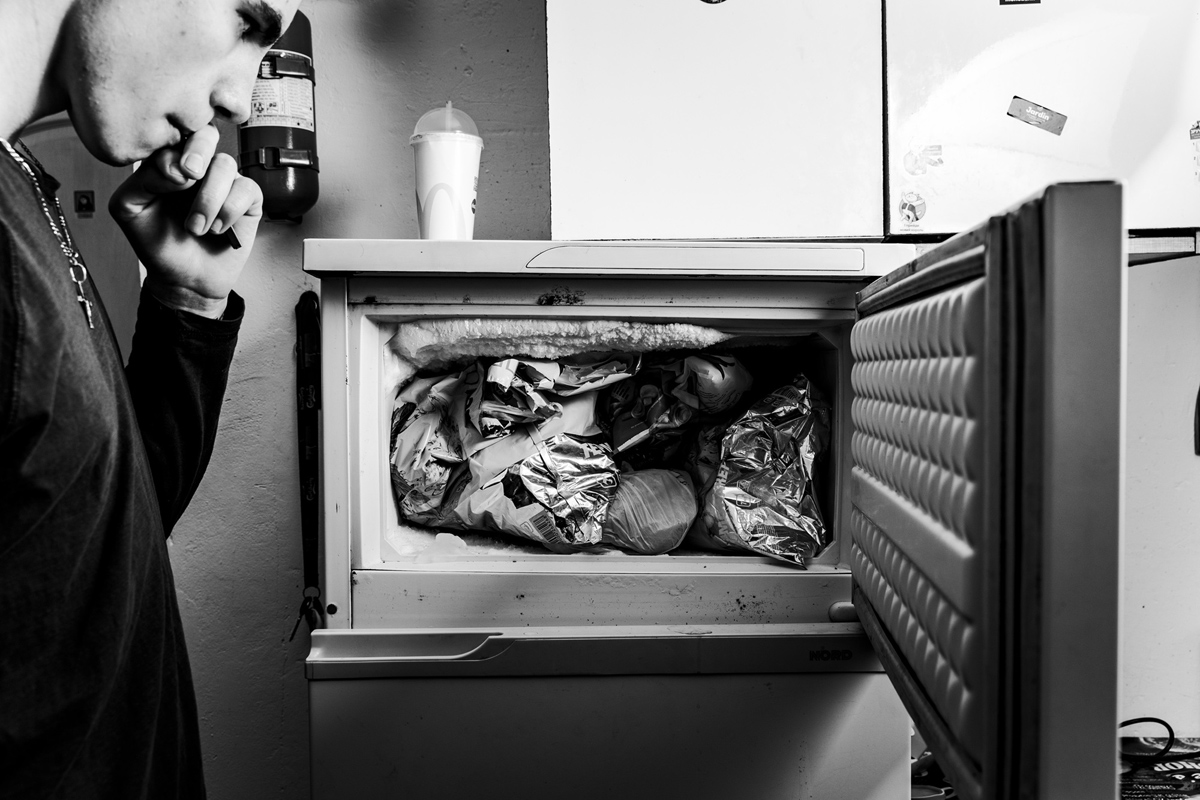
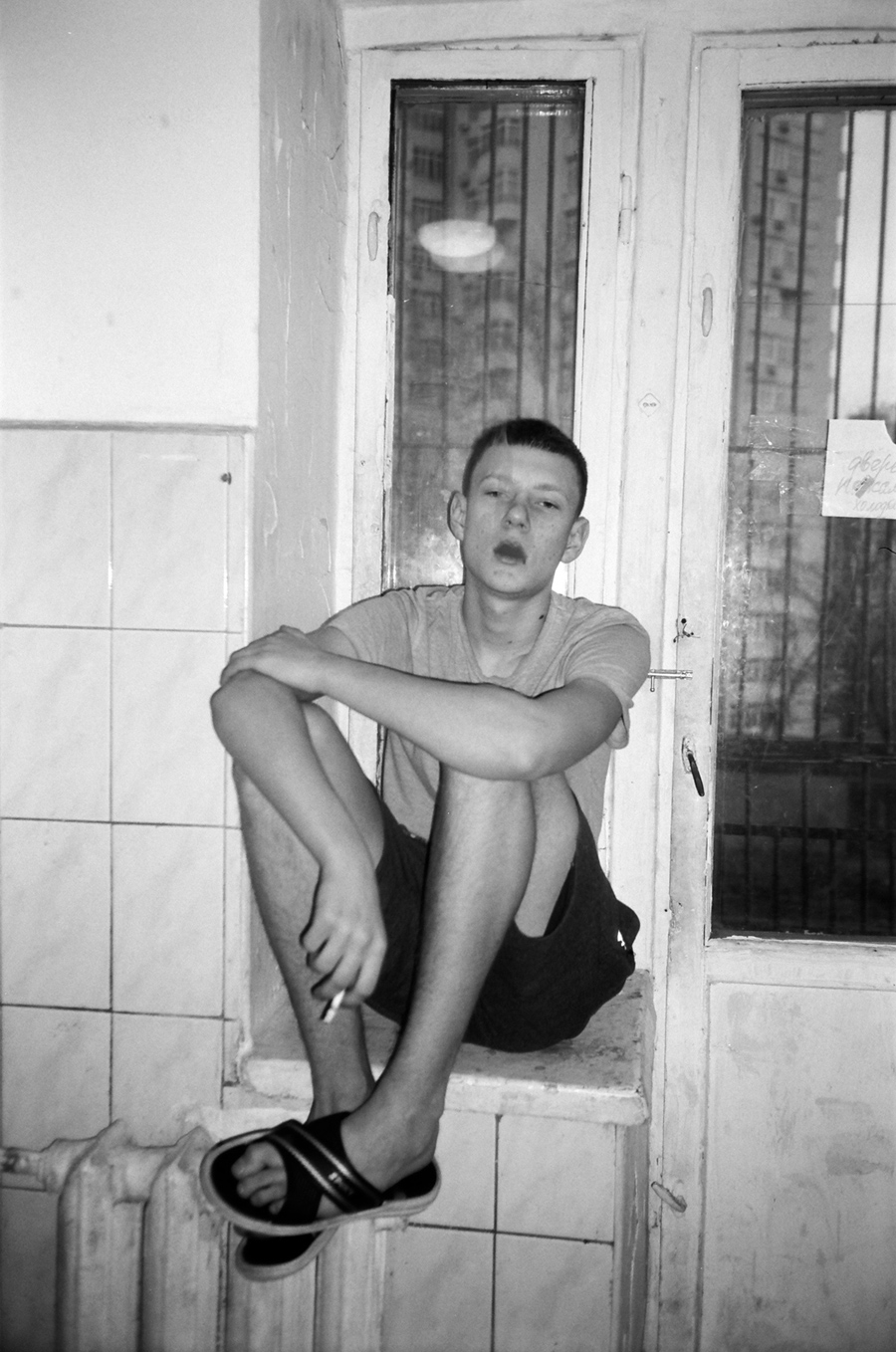
— Have you thought about shooting a group shot in that kind of environment? Have you thought about creating a broader story and including someone else?
— This shot was the beginning of the project before lockdown, and then it was all shut down. The students came back some time later in 2020. And I shot again in several dorms. I took a lot more pictures of different people. It’s chaos inside there: there’s the full package, namely partying, fighting, drugs, drinking, love.
— Did you shoot all this?
— Yes, I was predominantly focused on portraits of people that were a little out of context: I didn’t want to include all the blackness that surrounded us.
— Did you want to focus on other things?
— Yes, that’s right, I just wanted to focus on the person.
— But at the same time, it seems to me that your characters (maybe it’s because you shoot a lot of models) are always very beautiful by the standards of beauty that are possible in general. It’s rare to see people who are not standardized in your work. I think you know what I mean.
— Yes, I understand. That was my point from the beginning. Because it was very exciting for me, it was an exhilarating beauty, I tried to idealize the youth, the person and the body.
Over time, I began to get rid of this idealizing stamp and gradually went into a series that I shoot very ascetic now. So far I haven’t published such pictures anywhere. These are portraits of guys and girls with the same simple scenery using a large format static camera and 4 × 5 inch film sheets. I’m capturing what I imagine a person to be like. I line up a simple composition on ground glass and I see the person upside down and it helps me not to focus on the pose or facial expression at all and take everything as it is.
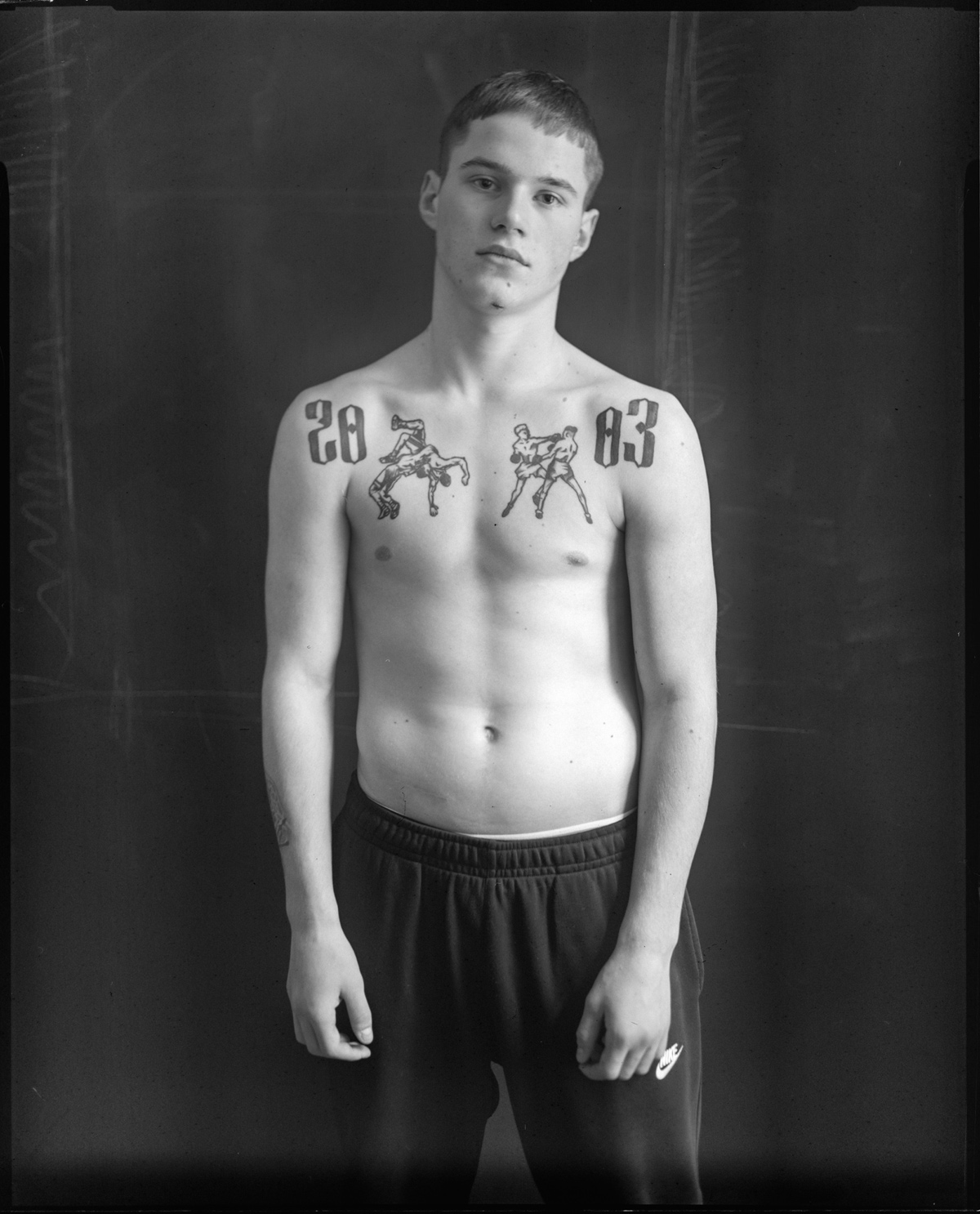
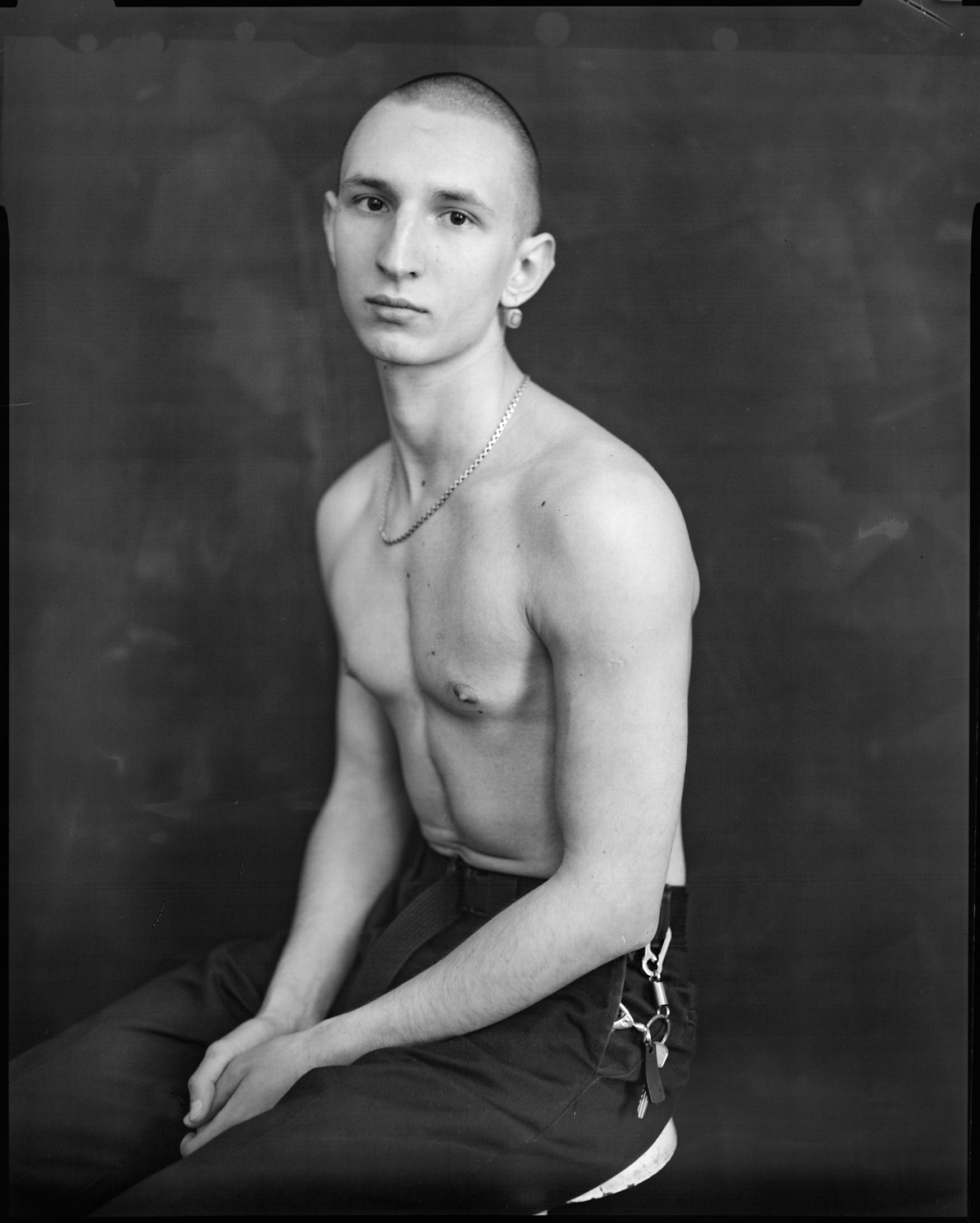
I choose beautiful natures, but with a kind of mystery. As they say, beauty is in the eye of the beholder. Everyone has their own canons, some are universally accepted, and some are internal, which I navigate through.
— What is interesting about your zine with Kyrylivska? How did you create this project?
— It all started when I made the cover for the first vinyl that the Standard Deviation label from Kyrylivska put out, and everybody loved it.
The guys found out that I had a whole project on this subject, and we decided together to make a zine and exhibition in the premises of the club after that. By the way, you can still see it now.
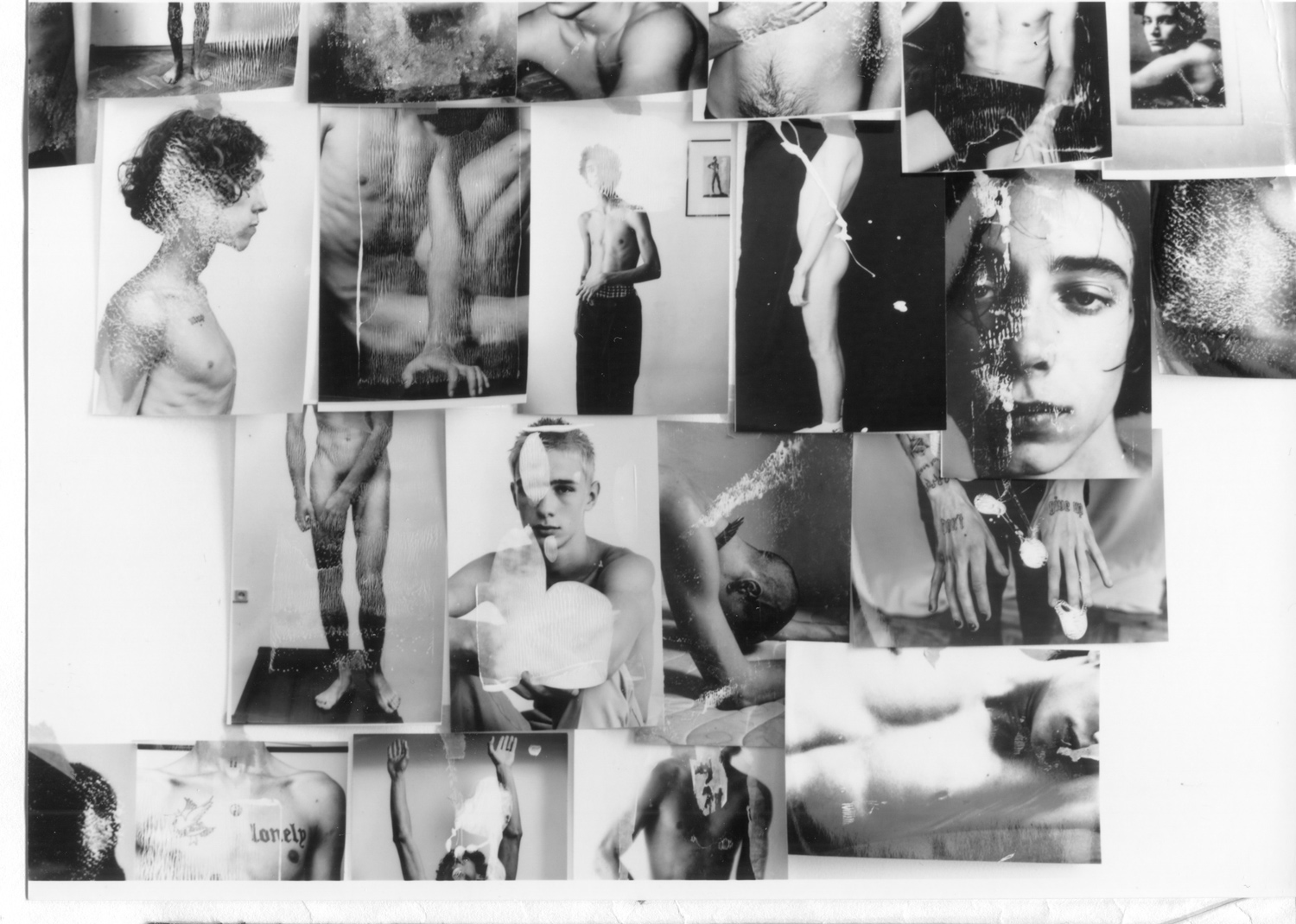
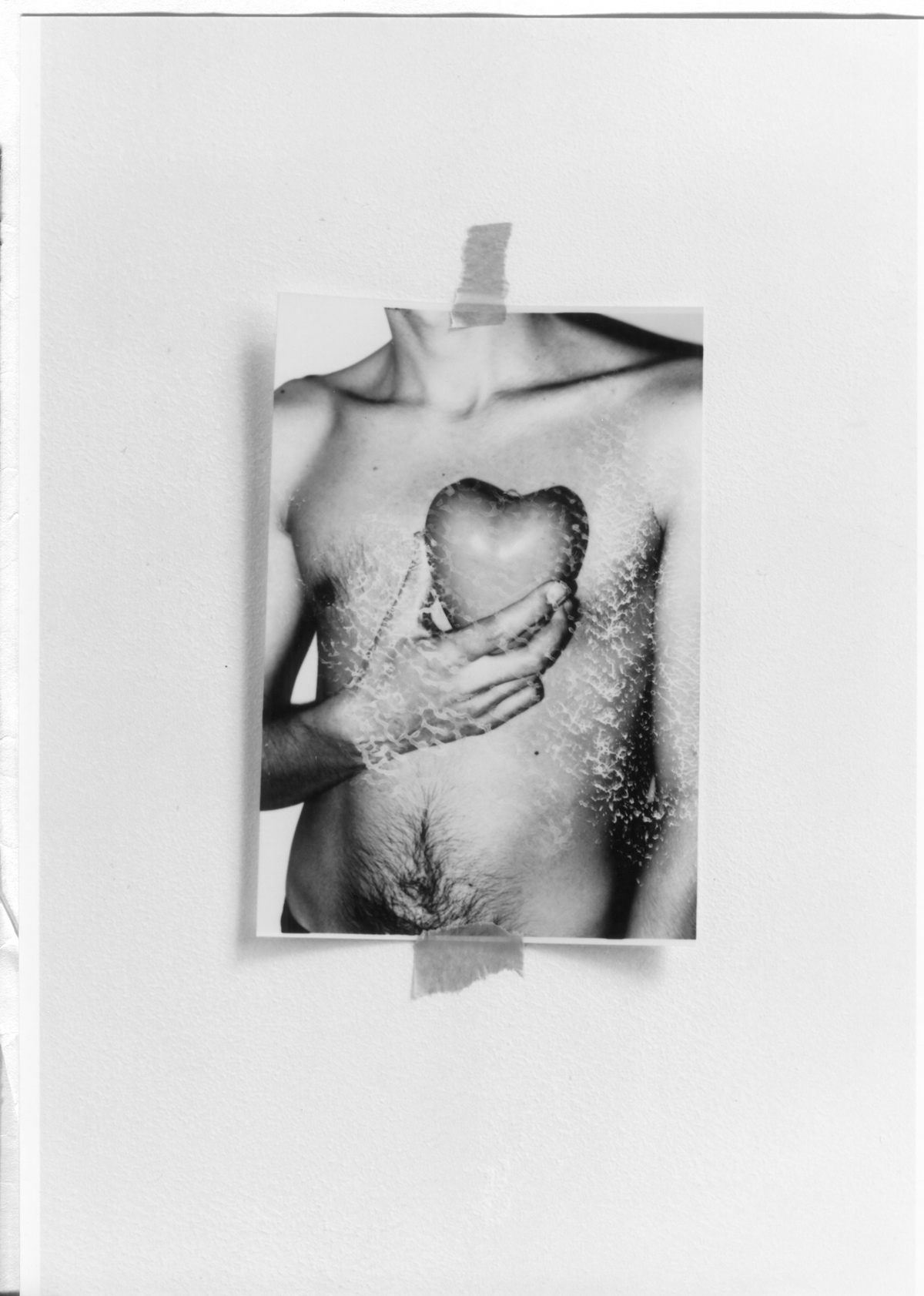
Heavy Clouds emerged at the beginning of the pandemic. At some point I stopped photographing people in my studio and immersed myself in the archives. I’m always printing photos, at least in small sizes. I have a bunch of them. Sometimes I vaguely remembered how these photos were even taken, because some of them were five or seven or more years old.
Then I discovered a new theme, namely paint, just like when I was a kid. In addition to photographs of bodies, a new variable was added, namely multiple layers and textures of paint. This is my way of conveying the white spots in my memory. My attempt to dive into the depths of a bygone eternal youth. These works can be called objects, but they are flat pictures within a zine.
— If you were doing a book, like an art book, what would it be?
— What would the book be like? — Good question, I need to imagine something that isn’t there yet… I think it would be cleaner, more photographic, in a classic way. For me, content is more important than presentation.
— It seems to me that your pictures are very tender. Are you doing it on purpose or are you willing to touch some dirt?
— I’m always looking for humanity. This is my soul constitution. I don’t think I could enter the territory of objectification, vulgarity, and impertinence even if I wanted to: it’s not about me at all.
— Where do you get your inspiration from, as clichéd as it sounds? Maybe you had some contact with the Kharkiv or Dnipro school of photography. Or are you not interested in it?
— My friend and I were recently discussing this. She asked me who else in Kyiv was shooting men’s nudes.
— I think one of the first was Yevhen Pavlov.
— Yes, but this is a project from 50 years ago («Violin» by Yevhen Pavlov). I can also mention Jury Rupin’s series («Bathhouse») from those times, it’s wow in terms of male nature. And it’s very timeless in terms of visuals, although it’s clear that Public Bath is more about the Soviet phase. It’s hard to single out any contemporary photographers now; I like the individual work of some of the guys, but they still need to be watched.
I am very inspired by several foreign photographers. I studied at JH Engström workshop in Copenhagen. It’s an honest, straightforward and wild mix of everything. He photographs everything that life is made of, namely cities, landscapes, people, nudes.
I started doing rural landscapes not so long ago. You start to appreciate the nature and the countryside even more after living for a long time in the megalopolis. One of the strong inspirations is Semyon Prosyak with his series «Sedniv» (village in Chernihiv region). These are black and white photos that show the 70’s and 80’s, incredible views and people.

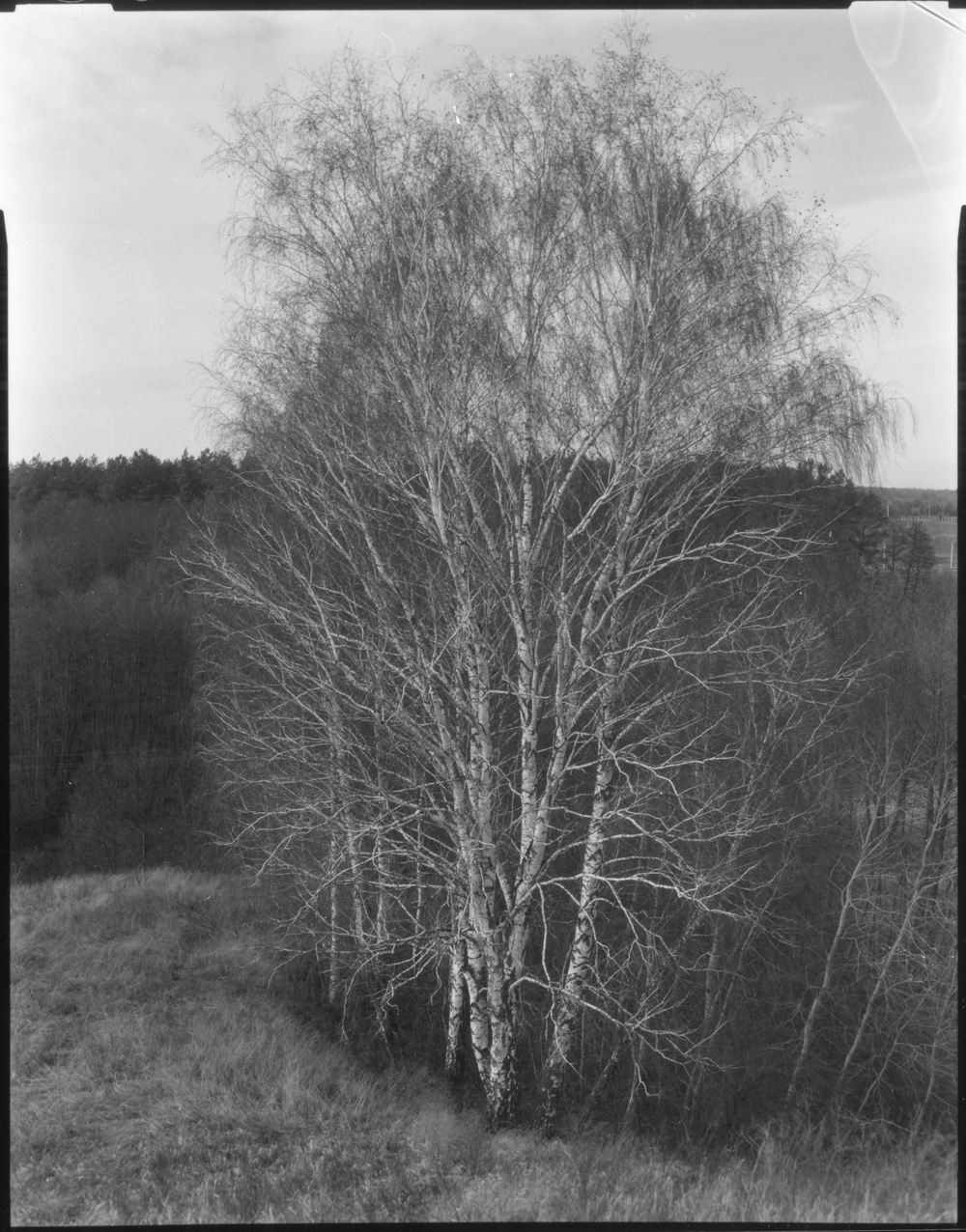
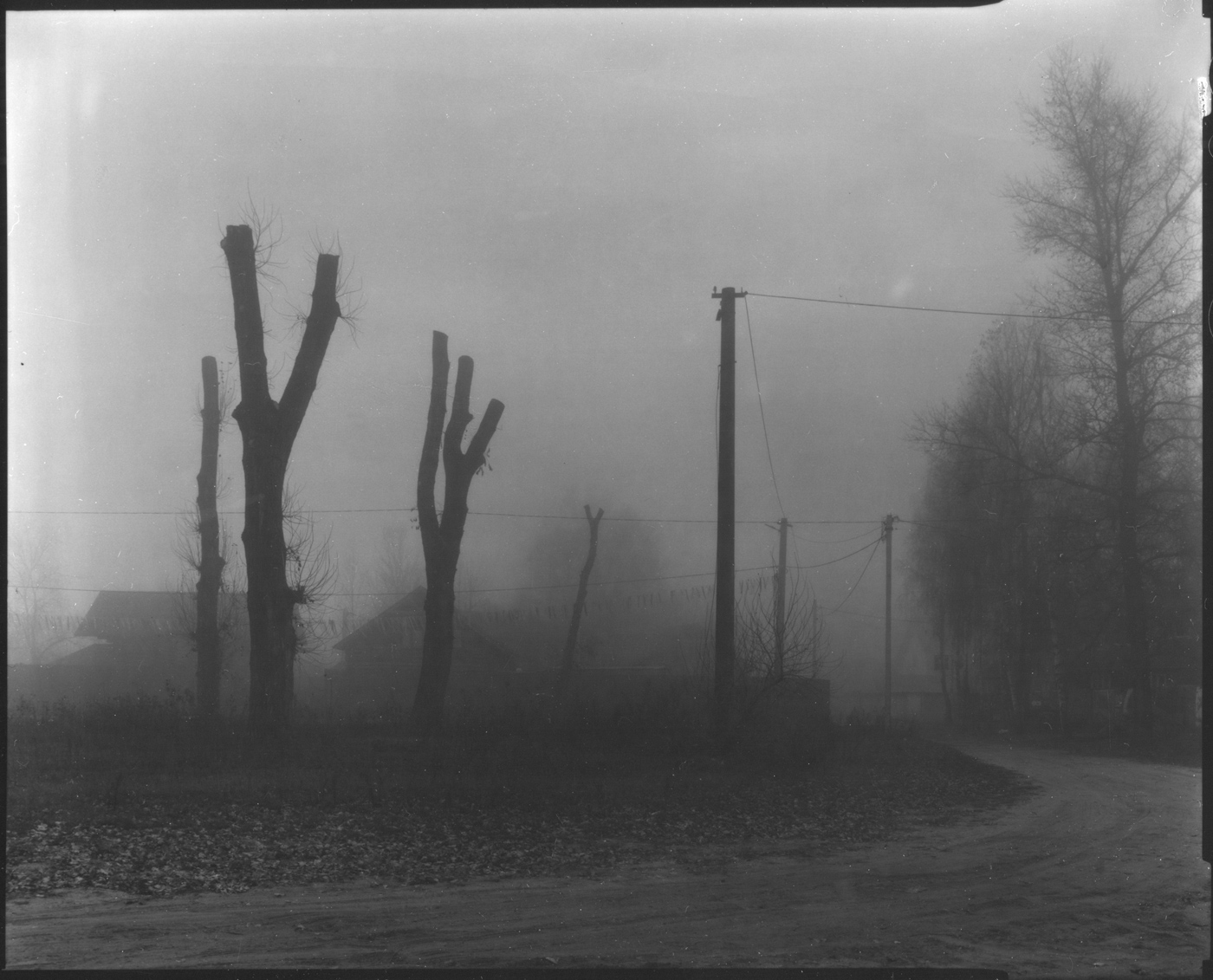
— What else inspires you?
— I am inspired by beautiful people, but not just outwardly. I wonder what the eyes «broadcast», the whole presentation is interesting, not just the body. I recently found an interesting quote by Oscar Wilde about beauty. He says, «All art is absolutely useless. Put usefulness first, and you lose it. Put beauty first,and what you do will be useful forever!» It’s about making it beautiful and even more beautiful. Though I may be slowly abandoning that and learning to accept things as they are.
